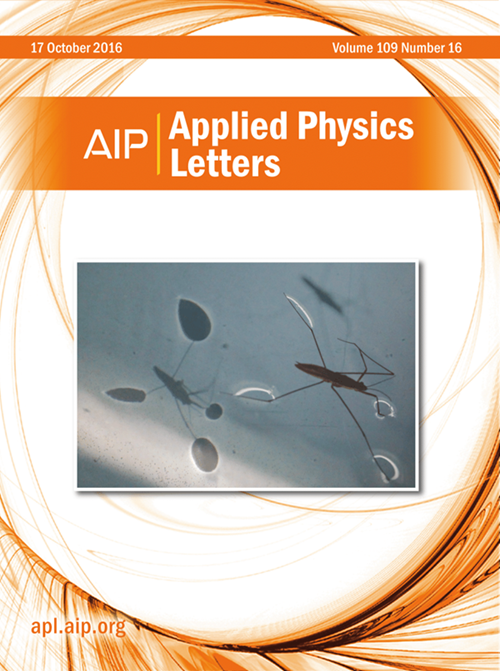Thickness-driven drastic transition in the electrical conductivity of ultrathin MoS2 films grown by pulsed laser deposition
IF 3.6
2区 物理与天体物理
Q2 PHYSICS, APPLIED
引用次数: 0
Abstract
We report on the pulsed laser deposition of ultrathin MoS2 films and how their electrical conductivity is significantly sensitive to thickness variation. It is shown that the thickness of MoS2 ultrathin films can be fairly controlled over the (1.3–12.6) nm range by simply adjusting the number of incident laser ablation pulses (NLP). Noteworthy, the electrical conductivity of the MoS2 ultrathin films was found to change by more than 6 orders of magnitude, abruptly switching from semiconducting to conductive behavior, upon increasing the thickness in the nm range. Raman analyses revealed that our ultrathin films comprise both 2H and 1T phases with a clear tendency for the metallic 1T phase to increase at the expense of its 2H phase counterpart, as the film thickness is increased from 1.3 to ∼13 nm. Concomitantly, their density of defects also increases with N. Our results highlight the significant structural and electrical changes that occur in MoS2 ultrathin films as their thickness is barely increased from a few to only several layers. A direct relationship between the conductivity of the pulsed laser deposition (PLD)-MoS2 ultrathin films and their structural characteristics (both 1T-MoS2 phase content and density of defects) is established. Finally, this work paves the way for the PLD as an effective synthesis route for the controlled growth of hybrid 2H-/1T-MoS2 ultrathin films with the possibility of wafer scaling.厚度驱动的脉冲激光沉积超薄二硫化钼薄膜电导率的急剧转变
我们报道了脉冲激光沉积超薄二硫化钼薄膜及其电导率如何对厚度变化显着敏感。结果表明,在(1.3 ~ 12.6)nm范围内,通过调整入射激光烧蚀脉冲(NLP)的数量,可以较好地控制MoS2超薄膜的厚度。值得注意的是,发现MoS2超薄膜的电导率变化超过6个数量级,当厚度增加到nm范围时,突然从半导体行为转变为导电行为。拉曼分析表明,我们的超薄膜包括2H相和1T相,随着薄膜厚度从1.3 nm增加到~ 13 nm,金属1T相明显增加,而2H相则增加。同时,它们的缺陷密度也随着氮的增加而增加。我们的研究结果突出了在MoS2超薄膜中发生的显著的结构和电学变化,因为它们的厚度几乎从几层增加到只有几层。建立了脉冲激光沉积(PLD)-MoS2超薄膜的电导率与其结构特性(1T-MoS2相含量和缺陷密度)之间的直接关系。最后,这项工作为PLD作为一种有效的合成路线铺平了道路,可以控制生长具有晶圆缩放可能性的杂化2H-/1T-MoS2超薄膜。
本文章由计算机程序翻译,如有差异,请以英文原文为准。
求助全文
约1分钟内获得全文
求助全文
来源期刊

Applied Physics Letters
物理-物理:应用
CiteScore
6.40
自引率
10.00%
发文量
1821
审稿时长
1.6 months
期刊介绍:
Applied Physics Letters (APL) features concise, up-to-date reports on significant new findings in applied physics. Emphasizing rapid dissemination of key data and new physical insights, APL offers prompt publication of new experimental and theoretical papers reporting applications of physics phenomena to all branches of science, engineering, and modern technology.
In addition to regular articles, the journal also publishes invited Fast Track, Perspectives, and in-depth Editorials which report on cutting-edge areas in applied physics.
APL Perspectives are forward-looking invited letters which highlight recent developments or discoveries. Emphasis is placed on very recent developments, potentially disruptive technologies, open questions and possible solutions. They also include a mini-roadmap detailing where the community should direct efforts in order for the phenomena to be viable for application and the challenges associated with meeting that performance threshold. Perspectives are characterized by personal viewpoints and opinions of recognized experts in the field.
Fast Track articles are invited original research articles that report results that are particularly novel and important or provide a significant advancement in an emerging field. Because of the urgency and scientific importance of the work, the peer review process is accelerated. If, during the review process, it becomes apparent that the paper does not meet the Fast Track criterion, it is returned to a normal track.
 求助内容:
求助内容: 应助结果提醒方式:
应助结果提醒方式:


